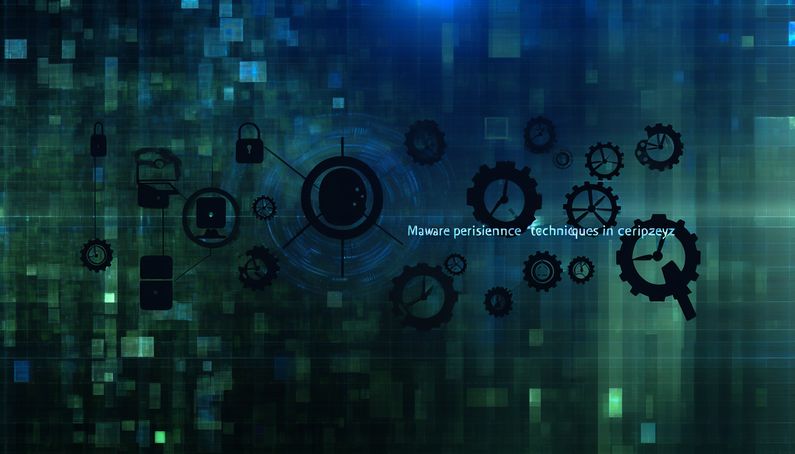
Understanding and Defending Against Malware Persistence Techniques
Malware persistence techniques are the stealthy tactics that cybercriminals use to maintain their grip on compromised systems. These methods allow attackers to survive system reboots and other changes, ensuring their malicious activities continue unabated. Understanding these techniques is crucial for developing robust defenses. For instance, attackers often exploit scheduled tasks and jobs, a method cataloged in the MITRE ATT&CK framework, to run malicious code at regular intervals. Similarly, boot or logon initialization scripts, identified as T1037 in the MITRE ATT&CK framework, are manipulated to execute harmful scripts during system startup or user logon. These strategies, among others, highlight the need for comprehensive security measures.
Wazuh, an open-source security platform, plays a pivotal role in detecting and mitigating these persistence techniques. It offers a unified Security Information and Event Management (SIEM) and Extended Detection and Response (XDR) solution, providing a centralized view for threat detection across various environments. With capabilities like File Integrity Monitoring (FIM) and Security and Configuration Assessment (SCA), Wazuh helps organizations identify unauthorized changes and assess their security posture, making it an essential tool in the fight against malware persistence.
Understanding Malware Persistence Techniques
Malware Persistence Techniques Overview
Malware persistence techniques are strategies employed by attackers to maintain long-term access to compromised systems, even after reboots or other system changes. These techniques are crucial for attackers to ensure their malicious activities can continue without the need for re-exploitation. Understanding these techniques is vital for developing effective defense mechanisms.
Common Techniques for Achieving Persistence
Scheduled Tasks and Jobs
One of the most prevalent methods used by attackers to achieve persistence is through scheduled tasks and jobs. By abusing task scheduling features, adversaries can run malicious code repeatedly or at set intervals. This technique is cataloged in the MITRE ATT&CK framework as T1053. Built-in utilities such as Task Scheduler on Windows, cron on Linux (a time-based job scheduler), and launchd on macOS (a system and service manager) are often exploited to execute programs or scripts at specified times or in response to certain events.
Boot or Logon Initialization Scripts
Attackers often configure scripts to execute during system boot or user logon to ensure persistence or privilege escalation. This technique is identified as T1037 in the MITRE ATT&CK framework. On Linux systems, mechanisms like rc.local, init.d, or systemd are commonly used to launch malicious code at startup. These scripts can be modified to include malicious payloads that execute every time the system starts or a user logs in, providing attackers with a reliable foothold.
System Process Creation or Modification
Modifying or creating system processes is another method attackers use to maintain persistence. This technique, known as T1543 in the MITRE ATT&CK framework, involves creating new processes or altering existing ones to execute malicious code. Attackers may modify system services or daemons to include their payloads, ensuring that their code runs with elevated privileges and remains undetected for extended periods.
Impact of Malware Persistence Techniques
Extended Dwell Time
Malware persistence techniques significantly extend the dwell time of attackers within a compromised environment. This prolonged presence, often lasting weeks or months, provides attackers with ample opportunity to explore the network, escalate privileges, and plan their next moves carefully before detection. The extended dwell time increases the potential for damage and data exfiltration, making it a critical concern for organizations.
Remediation Evasion
Persistence mechanisms make it challenging to fully remediate compromised systems. Even after initial removal, attackers can regain access using persistence techniques such as scheduled tasks, malicious services, or unauthorized user accounts. This makes cleanup efforts ineffective unless all persistence mechanisms are identified and removed. Organizations must employ comprehensive detection and response strategies to address these challenges effectively.
Data Exfiltration and Additional Malware Deployment
Persistent access is often used in Advanced Persistent Threats (APTs) to exfiltrate data over an extended period. This allows attackers to gradually steal sensitive information, such as credentials or business data, without raising immediate suspicion. Additionally, with continuous access, attackers can introduce additional malicious tools, including ransomware, backdoors, or remote access trojans, further compromising the system or expanding the attack surface across the network.
Defense Strategies Against Malware Persistence
Patch Management
Effective patch management is crucial in defending against malware persistence techniques. Many persistence methods exploit known vulnerabilities in operating systems, applications, or drivers. By regularly applying patches to these components, organizations can significantly reduce the available attack surface and prevent attackers from leveraging these vulnerabilities to maintain persistence.
File Integrity Monitoring (FIM)
File Integrity Monitoring (FIM) is a critical component of a robust defense strategy against persistence techniques. FIM helps detect unauthorized changes to critical files, such as startup scripts, scheduled task configurations, registry keys, or application binaries. By monitoring these sensitive files, organizations can identify when attackers attempt to gain persistence and take appropriate action to mitigate the threat.
User Account Monitoring
Persistence often involves creating new user accounts, modifying existing ones, or escalating privileges. Continuous monitoring of account creation, deletion, and permission changes can reveal suspicious behavior indicative of persistence attempts. Implementing robust user account monitoring practices can help organizations detect and respond to unauthorized account activities promptly.
System Configuration Hardening
Securing baseline configurations reduces the risk of attackers abusing system features for persistence. This includes disabling unused services, enforcing strong password policies, limiting administrative privileges, and using group policies to restrict autorun behavior. By hardening system configurations, organizations can minimize the opportunities for attackers to establish persistence on their systems.
Proactive Threat Hunting
Conducting proactive threat hunts allows security teams to detect hidden persistence mechanisms that evade automated tools. This includes searching for suspicious behavior, such as unusual process executions, scheduled tasks, or long-dormant malware. By actively hunting for threats, organizations can identify and mitigate persistence techniques before they lead to significant damage.
Wazuh’s Role in Detecting and Mitigating Persistence Techniques
Unified SIEM and XDR Protection
Wazuh provides a free and open-source enterprise-ready security solution that offers unified Security Information and Event Management (SIEM) and Extended Detection and Response (XDR) protection across various workloads. It provides a centralized view for threat detection and security monitoring across virtualized, on-premises, cloud-based, and containerized environments. Wazuh’s capabilities include active response, File Integrity Monitoring (FIM), Security and Configuration Assessment (SCA), log data analysis, and vulnerability detection.
Active Response and File Integrity Monitoring
Wazuh enhances threat defense by providing several capabilities to detect and respond to suspicious activity across monitored endpoints, including malware persistence techniques. It enables security teams to monitor for unauthorized changes, scheduled tasks, unusual processes, account modifications, and other indicators of compromise. The Wazuh agent, running on a monitored endpoint, collects and forwards system and application logs to the Wazuh server for analysis. This helps identify signs of malware persistence, such as unauthorized account creation, changes to startup folders or registry keys, and modifications to services.
Security and Configuration Assessment
Wazuh’s Security and Configuration Assessment (SCA) module helps organizations assess their security posture and identify configuration weaknesses that attackers could exploit for persistence. By conducting regular assessments, organizations can ensure that their systems are hardened against potential persistence techniques and maintain compliance with regulatory standards.
Vulnerability Detection
The Wazuh Vulnerability Detection module identifies vulnerabilities in the operating system and installed applications by correlating software inventory with known vulnerability data in the Wazuh CTI. This proactive approach allows organizations to address vulnerabilities before attackers can exploit them for persistence, reducing the risk of long-term compromise.
Community Support and Professional Assistance
Wazuh offers a vibrant community for professional support, enabling organizations to strengthen their defense strategy against malware persistence techniques. By leveraging community resources and professional assistance, organizations can stay informed about the latest threats and best practices for defending against persistence techniques.
In summary, understanding malware persistence techniques is crucial for developing effective defense strategies. By leveraging solutions like Wazuh and implementing comprehensive detection, prevention, and response measures, organizations can mitigate the risks associated with malware persistence and protect their systems from long-term compromise.
Final Thoughts
In the battle against malware persistence, understanding the enemy’s tactics is half the victory. Techniques like scheduled tasks, boot scripts, and system process modifications allow attackers to maintain a foothold in compromised systems, often going undetected for extended periods. This persistence not only increases the potential for data exfiltration but also complicates remediation efforts.
Wazuh emerges as a formidable ally in this fight, offering tools that enhance visibility and control over system configurations and activities. By leveraging Wazuh’s capabilities, such as active response and vulnerability detection, organizations can proactively address vulnerabilities before they are exploited. The platform’s community support further strengthens its utility, providing access to a wealth of knowledge and resources to stay ahead of emerging threats. As cyber threats evolve, so must our defenses, and Wazuh provides a robust framework to do just that.
References
- MITRE ATT&CK framework. (n.d.). Scheduled Tasks/Jobs [T1053]. Retrieved from https://attack.mitre.org/techniques/T1053/
- MITRE ATT&CK framework. (n.d.). Boot or Logon Initialization Scripts [T1037]. Retrieved from https://attack.mitre.org/techniques/T1037/
- MITRE ATT&CK framework. (n.d.). System Process Creation/Modification [T1543]. Retrieved from https://attack.mitre.org/techniques/T1543/



